Articles on Animation &Independent Animation 13 Jan 2010 09:02 am
Canemaker meets Dunning – 1980
The Jan-Mar 1980 issue of Animafilm included this interview with George Dunning by John Canemaker. John was very taken by the Dunning film in progress, The Tempest, and he starts off his interview with questions about that film.
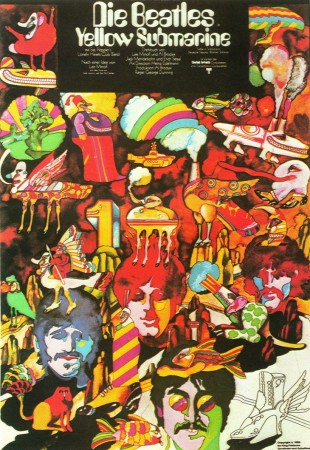
One has to live
George Dunning talks with John Canemaker
JOHN CANEMAKER: I saw a pencil test of “The Tempest” five years ago on CBS-TV. Are you still working on this film?
GEORGE DUNNING: I am indeed. More so, stronger on it than I was then. I’ve got a few hits and pieces in a rather unfinished state and some more going on now. It’s an attempt to he as personal as I can be. My approach is to do a few minutes to present to hackers. To justify doing Shakespeare as an animated film. Obviously live-action with stars and so on is a great advantage in box-office terms. People ask me why do it in animation. It’s all very well with the fantasy side of it, that seems appropriate. But beyond that, it’s something that I think should be demonstrated. And that’s what I’m doing, and then that helps open a technical line on it as well so that others can carry on.
J.C.: Will you be removing the words as you did with the poem you based “Damon the Mower” on?
G.D.: This is a difficult thing to make a statement about cause I’m in the middle of it. I might change my mind and do it all differently. But at this stage I find that I’m always taking out. I’ve taken a sequence of dialogue and cut it enormously -taken out half of it. Then I look at it and I take out more. I keep taking chunks away. I think this is legitimate but I am worried because it is tampering. But at the same time I think the verbal side of it, from a stage point of view, has a kind of function that on film is not necessary, if I could put it that way. I mean it sounds like I’m saying I know how to rewrite Shakespeare and I’m a bit timid about that. I just feel that in the end it is a film that one is making. I’m not rewriting Shakespeare, I’m making a film. In that sense it’s to use the dialogue but to pull a lot of it.
J.C.: The clip I saw showed a tree-like creature walking.
G.D.: That’s Caliban. He’s a tree through the whole thing. I just got carried away with that one phrase where he says, “This island is mine”. It just suddenly hit me, I saw this image of this tree, which is full of creatures as well. It’s sort of an ecology thing all together. And in the end of the play they leave and you have this island with Caliban left. And it’s sort of a hack-to-nature situation.
J.C.: Will you he mixing graphic techniques in the film?
G.D.: At this point it isn’t that far-out as far as technical things are concerned. I’ve been using ccl levels and Xerox drawings. It’s an attempt to keep things handle-able and in a condition where others can help. Cause if you get to do it in a technique which only one person can do it’s very limiting obviously.
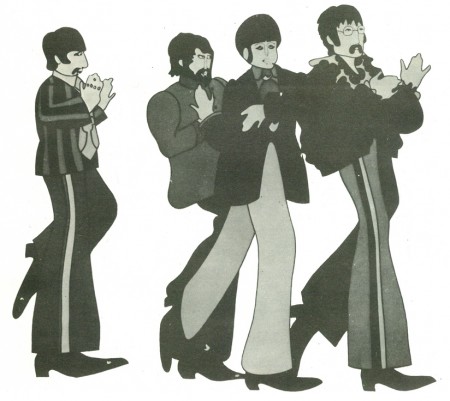
(Click any image to enlarge.)
J.C.: Do you work out of a studio in London?
G.D.: Yes, our studio is TVC London. It’s based on the name TV Cartoons. Auspicious name! And we’re having our twenty-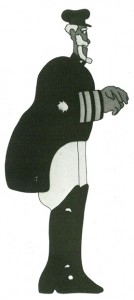 first birthday this year. In June we had it. It’s really a studio Dick Williams has had a lot to do with in the sense that he did a great deal to help in the early days to get it started. When I got to London he was working on “The Little Island”, and I helped him a little bit on that. Then he did a lot of commercials, a lot of stuff sort through our studio. I was sent over to London by Bosustow and UFA to set up a UFA satellite. They wanted to get some more footage for the “Gerald McBoing Show” on CBS. In those days Bosustow was on a big expansion drive and he sent Leo Salkin and me over to set that up. We set it up and seven months later UFA was practically bankrupt. This was ’56 or ’57.1 was in this position of going around to agencies cause we were doing commercials at that time and doing very well. Everyone was very glad that UFA was in London and so on. And Dick was doing commercials with us. So then I went around to all the agencies to say good-bye and they said, “Oh, stay. Can’t you keep this thing going? It’s marvelous”. So it was a matter of trying to make a set-up which I did with some businessmen. I had long talks with Dick, saying “What’ll I do…” And he said “I’ll help you and stick with it. This is great and you should stay on.” The prospect otherwise was
first birthday this year. In June we had it. It’s really a studio Dick Williams has had a lot to do with in the sense that he did a great deal to help in the early days to get it started. When I got to London he was working on “The Little Island”, and I helped him a little bit on that. Then he did a lot of commercials, a lot of stuff sort through our studio. I was sent over to London by Bosustow and UFA to set up a UFA satellite. They wanted to get some more footage for the “Gerald McBoing Show” on CBS. In those days Bosustow was on a big expansion drive and he sent Leo Salkin and me over to set that up. We set it up and seven months later UFA was practically bankrupt. This was ’56 or ’57.1 was in this position of going around to agencies cause we were doing commercials at that time and doing very well. Everyone was very glad that UFA was in London and so on. And Dick was doing commercials with us. So then I went around to all the agencies to say good-bye and they said, “Oh, stay. Can’t you keep this thing going? It’s marvelous”. So it was a matter of trying to make a set-up which I did with some businessmen. I had long talks with Dick, saying “What’ll I do…” And he said “I’ll help you and stick with it. This is great and you should stay on.” The prospect otherwise was
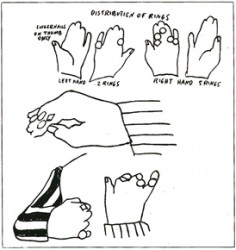 to go back to New York in tatters. It all seemed downhill. I remember Dick came to me exactly a year later and he said, “The year is up.” And I said, “What do you mean, the year is up?” He said, “I said I’ll help you, and give you a push. Now I really want to do stuff through my own company’s name and things like that.” We went on collaborating on some things but he was much more active with the Richard Williams Studio and developed it and so on. I have always had the greatest respect for all his abilities.
to go back to New York in tatters. It all seemed downhill. I remember Dick came to me exactly a year later and he said, “The year is up.” And I said, “What do you mean, the year is up?” He said, “I said I’ll help you, and give you a push. Now I really want to do stuff through my own company’s name and things like that.” We went on collaborating on some things but he was much more active with the Richard Williams Studio and developed it and so on. I have always had the greatest respect for all his abilities.
J.C.: So you set up your own company and were doing commercials?
G.D.: Lots of stuff like that and industrial films.
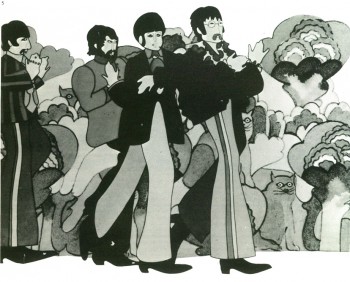
J.C.: Did you do features before the “Yellow Submarine”?
G.D.: No, we did a Saturday morning (TV) series
J.C.: Did you do features before the “Yellow Submarine”?
G.D.: No, we did a Saturday morning (TV) series for the Beatles music. King Features organized that with the Beatles and got permission to do cartoon versions of the four of them. It was terrifying. It was a very poor kind of design, but there it was. The show was very ordinary, very cheap cut-rate kind of thing. It was that kind of show with two numbers set into fifteen minutes framing it then another fifteen minutes to make the half hour. We made up a new half hour show one way or another each week, got to the lab then got that onto the plane, had the day off, then started in again, grinding on with this. It was King Features (newspaper syndicate) that had the idea to do a feature-length film and they kept hammering away to Brian Epstein (Beatles’ manager). He didn’t want to buy that for the longest time. Then finally agreed.
J.C.: Which would be around 1967?
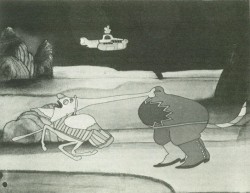 G.D.: Yes. So that’s why our studio did the thing. As I said, the design of the characters in the TV show was hopeless, although King Features had no objection. They were completely without any point of view on the thing. It was sort of business. We were desperate and I was jumping around like mad because I knew that had to be really well solved or we were dead. I tried with different kinds of designs. We got a bit of track of the four boys talking after they’d left the pot open once on a recording. So we took this talk and animated to it and kept testing and trying different things. We saw and had admired Heinz Edelmann’s graphic designs in “Twin” magazine. And thought why don’t we even try him. So we got in touch with him, he flew over and we showed him what we were doing and he disappeared for two weeks. I remember this brown envelope arrived with four drawings in it, one of each Beatle. It was really marvelous cause it had that solved, attended-to quality. You could see it wasn’t Mickey Mouse, it wasn’t this, it wasn’t that – it was just there! The film is very much a phenomenon.
G.D.: Yes. So that’s why our studio did the thing. As I said, the design of the characters in the TV show was hopeless, although King Features had no objection. They were completely without any point of view on the thing. It was sort of business. We were desperate and I was jumping around like mad because I knew that had to be really well solved or we were dead. I tried with different kinds of designs. We got a bit of track of the four boys talking after they’d left the pot open once on a recording. So we took this talk and animated to it and kept testing and trying different things. We saw and had admired Heinz Edelmann’s graphic designs in “Twin” magazine. And thought why don’t we even try him. So we got in touch with him, he flew over and we showed him what we were doing and he disappeared for two weeks. I remember this brown envelope arrived with four drawings in it, one of each Beatle. It was really marvelous cause it had that solved, attended-to quality. You could see it wasn’t Mickey Mouse, it wasn’t this, it wasn’t that – it was just there! The film is very much a phenomenon.
J.C.: It’s a time capsule of the sixties.
G.D.: It is that. That’s the contribution of many people. The film would have had a life because of the Beatles music.
That’s a separate consideration. And the fact that Heinz solved that side of it was so great and that was marvelous.
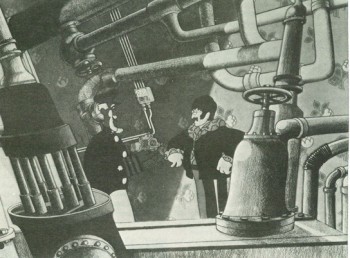 We had a budget of a million dollars, and eleven months to do it. The Beatles took $ 200,000, off the budget. There were three animation directions on it: Jack Stokes, who learned his trade with a group of people – a whole generation of animators in London – from a Disney man who came over, David Hand (Director of “Snow White”). Eddie Radich was another animation director on “Submarine”; Bob Balser, who has been for a long time in Barcelona. He’s the third director.
We had a budget of a million dollars, and eleven months to do it. The Beatles took $ 200,000, off the budget. There were three animation directions on it: Jack Stokes, who learned his trade with a group of people – a whole generation of animators in London – from a Disney man who came over, David Hand (Director of “Snow White”). Eddie Radich was another animation director on “Submarine”; Bob Balser, who has been for a long time in Barcelona. He’s the third director.
There was a period of about five months where we had 200 people working together in out studio in Soho Square. My memory of that time is that it was amazingly unfrantic, in the sense of devoted and productive. Everybody was very grim, hardworking. The whole atmosphere was “We’ll show them” meaning the rest of the world “that we can do this in London.” This odd thing of making a feature.
J.C.: This was the first British feature since “Animal Farm”?
G.D.: Absolutely yes. The film made money left and right. But it didn’t for TVC and very nearly bust us. That’s a very long and very bitter story. We had a really nasty time of it. We went over the budget, not a large amount over. The producer people through King Features organized to take over the company. And we learned an awful lot. Very bitter situation. After it was all over it got smoothed down. We repaired our relationship with King Features. But the whole thing was very sour.
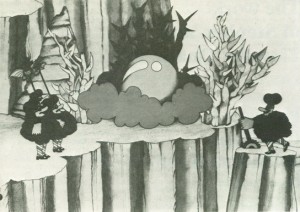 J.C.: You have retained your credentials as a film artist by making personal films. Is your work at TVC to help you to continue as an independent artist?
J.C.: You have retained your credentials as a film artist by making personal films. Is your work at TVC to help you to continue as an independent artist?
G.D.: I would guess that is the answer, yes. One has to live. I had a long stint at the Canadian Film Board. I learned a lot and enjoyed that kind of existence – government backing, budgets for films and all kinds of special facilities that you could get that way, that you don’t get out in the cold world of commerce.
J.C.: Who were some of the artistic influences in your career?
G.D.: McLaren. Alexeleff. Bartosch. Then there’s that whole world of Disney stuff that we’d all he poorer without, and I think in hits and pieces and in various ways it’s been an enormous influence.
J.C.: What is your age?
G.D.: 57
J.C.: Thank you very much for your time.
G.D.: Pleasure.
GEORGE DUNNING (1920-1979): FILMOGRAPHY
1943: J’AI TANT DANSE (I have danced so much), AUPRES DE MA BLONDE (By my blonde, Chants populates), 1944: GRIM PASTURES, 1945: THREE BLIND MICE, 1946: CADET ROUSSELIE, (UPRIGHT AND WRONG), 1947: THE ADVENTURES OF BARON MUNCHHAUSEN, FAMILY TREE (with Evelyn Lambard), 1959: THE WARDROBE, 1962: THE FLYING MAN, THE APPLE, 1968: CHARLEY, THE LADDER, THE YELLOW SUBMARINE, 1970: MOON ROCK, 1973: THE MAGGOT.
Publicity and sponsored films including: 1946: DISCOVERY – PENICILLIN, 1958: THE STORY OF THE MOTOR-CAR ENGINE, 1962: THE EVER-CHANGING MOTOR-CAR, 1962-65: THE ADVENTURES OF THUD AND BLUNDER (safety film for the Coal Board), 1966: BEATLES (TVseries with Jack Stokes), CANADA IS MY PIANO (with Bill Sewell).

on 13 Jan 2010 at 11:24 am 1.richard o'connor said …
What a well done interview.
on 14 Jan 2010 at 12:07 am 2.Charles Brubaker said …
I’m guessing Dunning never got to complete “The Tempest”, considering that this was published nearly a year after his death.
Very interesting interview, though. His recollection of the Yellow Submarine was worth reading.
on 15 Jan 2010 at 12:30 am 3.Pilsner Panther said …
There’s the answer to my question about the Beatles TV cartoon series… thank, you Michael! Having been a mere tot at the time, I can recall seeing it but not in any detail.
So George Dunning didn’t have a high opinion of the show, either. All too often (then and now) talented people who work in animation have to take on certain projects just to keep the paycheck coming in. They know it, so do the more perceptive people in the audience, and the only ones who don’t are the “suits” in the front office.
on 03 Nov 2012 at 3:14 pm 4.Historicist: The Animated Life of George Dunning | One Stop News Stand said …
[...] His partnership with Coates proved to be long and prosperous. But, in an interview with Animafilm published in January 1980, Dunning also credited Williams as being vital to TVC’s foundation. By then an established and in-demand animator producing commercials and his own Little Island (1958) project, Williams agreed to work with them until the venture company got off the ground. [...]
on 20 Aug 2019 at 12:42 am 5.Richard Williams (1933-2019), A Director, Animator, And Educator Who Pushed The Art Of Animation Forward – Latest Feed said …
[…] Following the success of that short, he started working at the London commercial studio TV Cartoons, started by George Dunning. “It’s really a studio Dick Williams has had a lot to do with in the sense that he did a great deal to help in the early days to get it started,†Dunning once said. […]
on 18 Feb 2023 at 3:40 pm 6.14 Animated Movies That Innovate With Style And Technology | Fishstream TV said …
[…] the mood and tone of the 1968 Beatles, yet the Beatles had little to do with it as they were overseas during production. Heinz Edelman designed the fabulous four to look like they were ripped from the Sgt. […]
on 18 Feb 2023 at 7:17 pm 7.14 Animated Movies That Innovate With Style And Technology – /Film – Auto Robot Demo said …
[…] the mood and tone of the 1968 Beatles, yet the Beatles had little to do with it as they were overseas during production. Heinz Edelman designed the fabulous four to look like they were ripped from the Sgt. […]